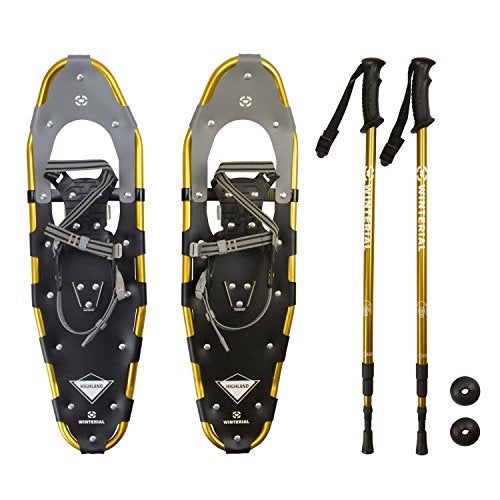
However, it’s still important to check the amount of traction they provide. Nowadays, all snowshoes come with crampons. While making your way up a slope, the last thing you want to happen is sliding back down. In addition to staying “afloat” on snow, it’s critical to make sure that your snowshoes have enough traction. While many women can use a unisex shoe, some might want to consider this option because it will fit better and be more comfortable. These shoes also have bindings that are sized to fit women’s footwear. These shoes feature narrower designs and sizes down to 8″ x 21″. Many manufacturers also make a women’s specific snowshoes. When checking out recommended loads, it’s important to know that these numbers are based on light, dry snow conditions. Take into account your own weight (the snowshoes will specify which weight range they support) and the most likely snow types of the region you’ll be snowshoeing most often. Some types combine these two styles and feature a teardrop shape, with a wide frame and a tapered tail.

Narrow tapered shapes have less flotation but allow for more speed. Oval shapes provide better flotation because of their larger surface area. In general, the lighter or drier the snow is or the heavier the hiker is, the more surface area is required for proper flotation. Snowshoes distribute your weight over a larger area so that your foot doesn’t sink completely into the snow, this is called flotation. The size of your snowshoes is the most important feature with regards to flotation. If you’re an adventurer looking to blaze your own trail, this type of snowshoe is for you. Designed for icy and steep slopes, they come with climbing-style crampons. They ‘ re suitable for experienced hikers, snowboarders and mountaineers. STEEP TERRAIN SNOWSHOES are specifically designed for backcountry use. These are arguably the most useful snowshoes for hiking because they work well for all but very steep terrain and icy conditions. Their flotation is better than that of recreational snowshoes. They are designed for use on trails on steeper slopes and rugged terrain. SLOPING TERRAIN SNOWSHOES are ideal for those who want to do more serious winter hiking and backpacking. They need less flotation because the trails are groomed. These recreational snowshoes have simpler traction and are shorter than the other two options. They’re made for easy walking on flat to gently rolling terrain and on well-groomed trails. Let’s talk about each type of shoe in detail so you can learn which is the best type of snowshoe for you.įLAT TERRAIN SNOWSHOES are the best snowshoes for beginners. There are also a few models that are made for specific activities such as climbing and trail running. There are three different types of snowshoes: flat terrain, sloping terrain and steep terrain snowshoes. HOW TO FIND THE BEST SNOWSHOES FOR HIKING TYPE OF SNOWSHOE


 0 kommentar(er)
0 kommentar(er)
